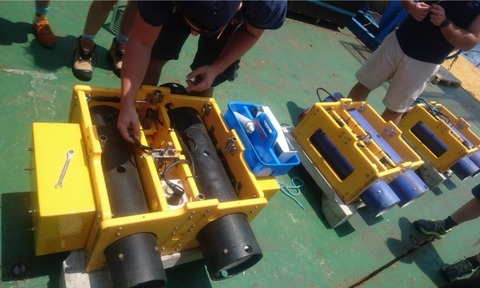Sea-savvy tech provides longest ever study of destructive water currents
16 Dec 2024

Durham University scientists have made a groundbreaking discovery in marine geoscience, using seabed seismographics to study the world’s strongest turbidity currents as they occur in one of the longest submarine canyons on Earth.
The Congo Canyon-Channel spans an estimated 500 km from the Atlantic Ocean to its easternmost point on the African continent. At its deepest it exceeds 1,000 metres, with a peak width of 14 km.
Employing ocean bed seismographic instruments, the researchers were able to study two massive turbidity currents travelling more than 1,000 kilometres, which attained speeds of up to 7.6 metres per second and lasted more than three weeks.
Their focus was the runout sediment flow – the journey of the debris churned up by the water’s activity. Data collected provided unprecedented insights into the dynamics of a process which shapes landscapes, transports organic carbon and material and can damage telecommunication cables.
The seismographs were able to operate outside the destructive paths of sediment, allowing the Durham team to complete what they claim to be the longest runout sediment flows ever directly observed on Earth, and in greater detail than previously attained.
The process can provide critical data on the duration, internal structure, and behaviour of turbidity currents, explained lead author Dr Megan Baker.
She said: “This multidisciplinary work brought together geologists, seismologists, and engineers to advance our understanding of powerful turbidity currents through first-of-their-kind observations using ocean-bottom seismographs.
“This approach enables the safe monitoring of these hazardous events and will help us learn where and how often turbidity currents occur globally.”
The research team also featured scientists from GEOMAR Helmholtz Centre for Ocean Research, the National Oceanography Centre, Georg-August-University, Deutsches GeoForschungsZentrum GFZ Potsdam, IFREMER, Université Paris-Saclay, TU Wien, as well as Newcastle, Hull, Southampton and Loughborough universities.
The use of seismographs offers a cost-effective method to monitor the impact of turbidity currents and other hazardous seabed events. It has also led to calls to reevaluate existing models derived from the study of shorter, shallower flows.
Despite causing substantial seafloor erosion, the fronts of the flows maintain a near-constant speed and duration, efficiently moving organic material and sediment vast distances to the deep-sea, say the researchers, challenging traditional models of turbidity current behaviour.

